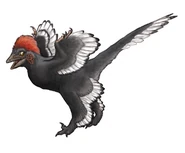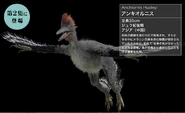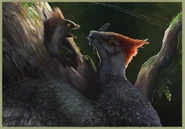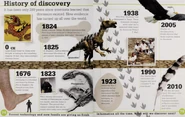| Anchiornis Temporal range: Late Jurassic | |
|---|---|

| |
| Joanna Kobierska's illustration of Anchiornis huxleyi | |
| Scientific classification | |
| Kingdom: | Animalia |
| Phylum: | Chordata |
| Class: | Sauropsida |
| clade: | Dinosauria |
| Superorder: | Theropoda |
| Genus: | †Anchiornis Xu et al., 2009 |
| Species: | A. huxleyi |
| Binomial name | |
| Anchiornis huxleyi Xu et al., 2009 | |
Anchiornis (meaning "near bird") was a small troodontid dinosaur that is the missing link between dinosaurs and birds. Scientists have learned its colouration due to fossil feathers.
The genus Anchiornis contains the type species Anchiornis huxleyi, named in honor of Thomas Huxly, an early proponent of biological evolution, and the first to propose a close evolutionary relationship between birds and dinosaurs. The generic name Anchiornis means "near bird", and its describers cited it as important in filling a gap in the transition between the body plans of Avian birds and non-avian dinosaurs.
Description[]
Anchiornis huxleyi was a small, paravian dinosaur with a triangular skull bearing several details in common with dromaeosaurids and troodontids. Anchiornis had very long legs, usually an indication that they were strong runners. However, the extensive leg feathers indicate that this may be a vestigial trait, as running animals tend to have reduced, not increased, hair or feathers on their legs. The forelimbs of Anchiornis were also very long, similar to archaeopterygids.
The first fossil was recovered from the Yaolugou locality, Jianchang County, western Liaoning, China; the second, at the Daxishan locality of the same area. The deposits are lake sediment, and are of uncertain age. Radiological measurements indicate an early Late Jurassic age for them, between 161 and 151 million years ago.
Feathers[]
While the first specimen of Anchiornis preserved only faint traces of feathers around the preserved portion of the body, the well-preserved second specimen showed nearly complete feather preservation, allowing researchers to identify the structure of the feathers and how they were distributed.
As in other early paravians such as Microraptor, Anchiornis had large wings, made up of pennaceous flight feathers attached to the arm and hand (as in modern birds) as well as flight feathers on the hind legs, forming an arrangement of fore and hind wings. The forewing of Anchiornis was composed of 11 primary feathers and 10 secondary feathers. Unlike Microraptor, the primary feathers in Anchiornis were about as long as the secondaries and formed a more rounded wing, with curved but symmetrical central vanes, a small and thin relative size, and rounded tips, all indicating poorer aerodynamic ability compared to its later relative. In Microraptor and Archaeopteryx, the longest forewing feathers were closest to the tip of the wing, making the wings appear long, narrow, and pointed. However, in Anchiornis, the longest wing feathers anchored near the wrist, making the wing broadest in the middle and tapering near the tip for a more rounded, less flight-adapted profile.
The hind wings of Anchiornis were also shorter than those of Microraptor, and were made up of 12–13 flight feathers anchored to the tibia (lower leg) and 10–11 to the metatarsus (upper foot). Also unlike Microraptor, the hind wing feathers were longest closer to the body, with the foot feathers being short and directed downward, almost perpendicular to the foot bones.
Unlike any other known Mesozoic dinosaur, the feet of Anchiornis (except for the claws) were completely covered in feathers (much shorter than the ones making up the hind wing).
Two types of simpler, downy (plumaceous) feathers covered the rest of the body, as in Sinornithosaurus. Long downy feathers covered almost the entire head and neck, torso, upper legs, and the first half of the tail. The rest of the tail bore pennaceous tail feathers (rectrices).
Colors[]
In 2010, a team of scientists examined numerous points among the feathers of an extremely well preserved Anchiornis specimen to survey the distribution of melanosomes, the pigment cells that give feathers their color. By studying the types of melanosomes and comparing them with those of modern birds, the scientists were able to map the specific colors and patterning present on Anchiornis when it was alive. Though this technique had been used and described for isolated bird feathers and portions of other dinosaurs (such as the tail of Sinosauropteryx), Anchiornis became the first Mesozoic dinosaur for which almost the entire life coloration was known (note that the tail of this specimen was not preserved).
Most of the body feathers of Anchiornis were gray and black. The crown of head feathers was mainly rufous with a gray base and front, and the face had rufous speckles among predominantly black head feathers. The fore and hind wing feathers were white with black tips. The coverts (shorter feathers covering the bases of the long wing feathers) were gray, contrasting the mainly white main wings. The larger coverts of the wing were also white with gray or black tips, forming rows of darker dots along mid-wing. These took the form of dark stripes or even rows of dots on the outer wing (primary feather coverts) but a more uneven array of speckles on the inner wing (secondary coverts). The shanks of the legs were gray other than the long hind wing feathers, and the feet and toes were black.
Discovery and history[]
The first known fossil of Anchiornis (its type specimen) was dug up in the Yaolugou area of Jianchang County, Liaoning, China. These rocks have been difficult to date, but most studies have concluded that they belong to the Tiaojishan Formation of rocks dated to the late Jurassic period (Oxfordian age), 160.89 to 160.25 million years old. studied and described by paleontologist Xu Xing and colleagues in a paper accepted to the Chinese Science Bulletin in 2009. The specimen is currently in the collection of the Institute of Vertebrate Paleontology and Paleoanthropology with the catalogue number IVPP V14378. It is an articulated skeleton missing the skull, part of the tail, and the right forelimb. The name Anchiornis huxleyi was chosen by Xu and colleagues in honor of Thomas Henry Huxley, an early proponent of biological evolution, and one of the first to propose a close evolutionary relationship between birds and dinosaurs. The generic name Anchiornis comes from combining the Ancient Greek words for "nearby" and "bird", because it was interpreted as important in filling a gap in the transition between the body plans of birds and dinosaurs.
A second specimen came to light around the same time, and was given to a team of scientists from Shenyang Normal University by a local farmer when they were excavating at the Yaolugou dig site. According to the farmer, this second specimen had been found nearby in the area of Daxishan, also from Tiaojishan Formation rocks of about the same age as the first Anchiornis. Two scientists visited the site in order to compare the new fossil with the rock types found there, and were able to confirm that the new specimen probably did come from the area the farmer described. They were able to dig up several fish fossils and a third Anchiornis fossil. The farmer's fossil underwent study which was published on September 24, 2009, in the journal Nature. It was assigned the catalogue number LPM – B00 169 in the Liaoning Paleontological Museum. It is larger and much more complete than the first specimen, and preserved long wing feathers on the hands, arms, legs and feet, showing that it was a four-winged dinosaur similar to Microraptor.
While only a few specimens have been described in detail, many more have been identified and are held in both private collections and museums. One of these, a nearly complete skeleton missing the tail, also preserving extensive feather remains, was reported in 2010. This fossil also showed evidence that Anchiornis had a feathered crest on its head, and was used to determine the animal's life coloration. It is housed in the Beijing Museum of Natural History with the specimen number BMNHC PH828. Another specimen from the same fossil quarry as the type specimen was found by a local fossil dealer and sold to the Yizhou Fossil & Geology Park and catalogued there as YTGP-T5199. This fossil, a nearly complete skeleton, was prepared and studied by scientists at the Geology Park and identified as an Anchiornis. It was then used for a scanning electron microscope study of Anchiornis feather microstructure. The study also examined the well-preserved melanosomes of the feathers to determine their color. The scientists involved in the study found that the coloration found for this specimen was different than the color reported for BMNHC PH828, and they noted that the BMNHC specimen may not in fact be Anchiornis, as it was described before similar species from the same formation had been discovered.
The Shandong Tianyu Museum of Nature in Pingyi County, China, for example, was reported to hold 255 specimens of Anchiornis in its collections in 2010. Among their collection is a very well preserved fossil with visible color patterns, catalogued as STM 0-214. While this specimen has yet to be fully described, it was photographed for a 2011 article in National Geographic and was used in a study of Anchiornis covert feathers and wing anatomy the following year.
Classification[]
When it was first discovered, the scientists who studied Anchiornis conducted a phylogenetic analysis and concluded that it was an early member of the group Avialae, along with Archaeopteryx. Members of Avialae, called avialans, are all more closely related to modern birds than they are to dromaeosaurid and troodontid dinosaurs, though the earliest and most primitive members of all three groups are extremely similar to each other, which makes it difficult to sort out exactly which of these three main paravian branches they belong to.
The second specimen of Anchiornis was more complete than the first, and preserved several features which led Hu Dongyu and his colleagues to reclassify Anchiornis as a troodontid. Several more studies using similar analyses have also found Anchiornis to be a troodontid, though there have been exceptions. One study found Anchiornis to be a member of Archaeopterygidae, and it along with Archaeopteryx were considered more primitive than dromeosaurids, troodontids, or avialans. In 2015, Sankar Chatterjee placed Anchiornis along with Microraptor and other four-winged paravians in a group he called "Tetrapterygidae", just outside the Avialae, though this was not supported with a phylogenetic analysis. More comprehensive studies suggested that Anchiornis may have been an avialan after all, though new finds and updated versions of the same study later reversed this finding, concluding that Anchiornis was most likely a basal member of the clade Paraves, just outside the clade that includes dromaeosaurids, troodontids, and avialans.
In a 2017 re-evaluation of the Haarlem Archaeopteryx specimen, Anchiornis was found to be in a group with other genera, like Eosinopteryx, Xiaotingia, and was placed in the family Anchiornithidae along with other relatives.
Paleobiology[]
Anchiornis is notable for its proportionally long forelimbs, which measured 80% of the total length of the hindlimbs. This is similar to the condition in early avians such as Archaeopteryx, and the authors pointed out that long forelimbs are necessary for flight. Anchiornis also had a more avian wrist than other non-avialan theropods. The authors initially speculated that it would have been possible for Anchiornis to fly or glide. However, further finds showed that the wings of Anchiornis, while well-developed, were short when compared to later species like Microraptor, with relatively short primary feathers that had rounded, symmetrical tips, unlike the pointed, aerodynamically proportioned feathers of Microraptor. A 2016 study of potential flight performance in early paravians concluded that while juvenile Anchiornis specimens may have been able to use their wings to assist running up an incline, and could possibly have achieved flapping flight if a very high-angle flapping wing stroke was used, the larger adult specimens would not have gained any aerodynamic benefit from their wings—they were simply too heavy compared to their total wing area. The same study found that flapping the wings while running would have resulted in a small (10%) increase to its running speed. Similarly, use of the wings during leaping would have resulted in a 15 to 20% increase in height and distance. Notably, Anchiornis seems to have lacked a breastbone (sternum), which may have been made of cartilage rather than bone, as in more primitive theropods. Fossil exhibited in Japan Anchiornis has hindleg proportions more like those of more primitive theropod dinosaurs than avialans, with long legs indicating a fast-running lifestyle. However, while long legs normally indicate a fast runner, the legs and even feet and toes of Anchiornis were covered in feathers, including long feathers on the legs, similar to those in the hindwings of Microraptor. Long leg feathers on the lower legs may have slowed the running speed of Anchiornis. In modern birds, especially those that live on the ground, the lower legs tend to show reduction or even loss of feathers. The hind wings of Anchiornis were smaller and made of more curved, symmetrical feathers than those of Microraptor, suggesting that they were used mainly for display rather than flight. However, they might still have granted the animal some kind of aerodynamic advantage, even if their primary purpose was for display or some other function.
The skeletal structure of Anchiornis is similar to Eosinopteryx, which appears to have been a capable runner due to its uncurved rear claws and absence of flight feathers on its tail or lower legs. Anchiornis shared a similar body plan and the same ecosystem as Eosinopteryx, suggesting different niches and a complex picture for the origin of flight.
Like many modern birds, Anchiornis exhibited a complex pattern of coloration with different colors in speckled patterns across the body and wings, or "within- and among-feather plumage coloration." In modern birds, such color patterning is used in communication and display, either to members of the same species (e.g. for mating or territorial threat display) or to threaten and warn off competing or predatory species.
A 2018 study reported gastric pellets in association with Anchiornis specimens; some of the Anchiornis were even preserved with pellets still inside their bodies. Anchiornis is the earliest theropod known to have produced pellets. The pellets contained lizard bones and ptycholepid fish scales.
In The Media[]
Anchiornis make its first media appearance in the new Netflix Original Documentary Series, Life on Our Planet, where a female, who is hunting insects, is being hunted herself by a juvenile Sinraptor.












